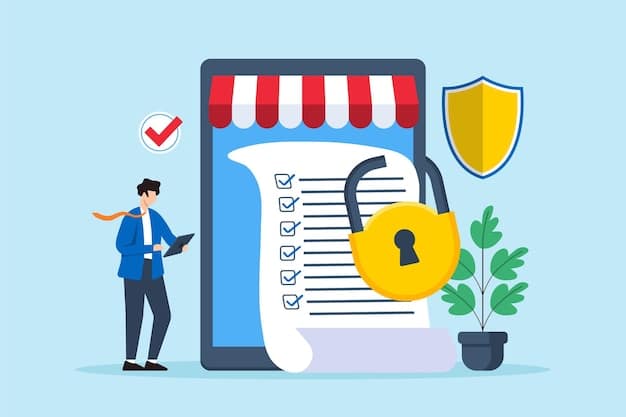Decoding PCI Compliance: A 2025 Guide for US E-commerce Businesses

Decoding PCI Compliance: A Step-by-Step Guide for US E-commerce Businesses in 2025 to Avoid Fines clarifies the Payment Card Industry Data Security Standard (PCI DSS) requirements, helping online stores protect customer data and avoid penalties.
Navigating the world of e-commerce in the US involves many crucial aspects, and one of the most vital is ensuring the security of your customers’ payment information. Decoding PCI Compliance: A Step-by-Step Guide for US E-commerce Businesses in 2025 to Avoid Fines is essential for any online business that accepts credit card payments. Failing to comply with these standards can lead to significant financial penalties and damage your reputation.
This guide aims to provide a clear, actionable roadmap for achieving and maintaining PCI compliance, keeping your business safe and secure in 2025.
Understanding PCI Compliance for E-commerce in 2025
PCI compliance, short for Payment Card Industry Data Security Standard (PCI DSS) compliance, are the set of security standards designed to protect cardholder data. For e-commerce businesses in the US, understanding and adhering to these standards is not just a best practice, but a necessity. Let’s dive into the essential aspects of PCI compliance for 2025.
Why is PCI Compliance Important?
Compliance with PCI DSS helps prevent data breaches and fraud, ultimately protecting your customers and your business. It also demonstrates a commitment to security, which can build trust and enhance your brand’s reputation. Moreover, non-compliance can result in hefty fines and penalties.
Who Needs to Comply with PCI DSS?
Any business that accepts, processes, stores, or transmits credit card information is required to comply with PCI DSS. This includes everything from small online stores to large e-commerce platforms. If you’re processing credit card payments, Decoding PCI Compliance: A Step-by-Step Guide for US E-commerce Businesses in 2025 to Avoid Fines is a must-read.
- All merchants, regardless of size or transaction volume
- Service providers involved in payment processing
- Any entity storing, processing, or transmitting cardholder data

The Consequences of Non-Compliance
Failure to comply with PCI DSS can lead to several negative consequences, including fines, increased transaction fees, legal liabilities, and damage to your business’s reputation. In severe cases, payment processors may even terminate your ability to accept credit card payments.
In summary, understanding the importance of PCI compliance is the first step toward securing your e-commerce business. By implementing the necessary security measures and following the guidelines, you can protect your customers, maintain your reputation, and avoid costly penalties. The next sections will explore how Decoding PCI Compliance: A Step-by-Step Guide for US E-commerce Businesses in 2025 to Avoid Fines can protect your business in 2025.
A Step-by-Step Guide to PCI Compliance in 2025
Achieving PCI compliance can seem daunting, but by breaking it down into manageable steps, the process becomes much more approachable. This section provides a clear, step-by-step guide to help US e-commerce businesses decoding PCI compliance: A Step-by-Step Guide for US E-commerce Businesses in 2025 to Avoid Fines and navigate the requirements effectively.
Step 1: Determine Your PCI DSS Compliance Level
The first step is to determine your business’s PCI DSS compliance level; this is based on your annual transaction volume. The higher the volume, the more stringent the requirements. Knowing your level helps you understand the scope of compliance efforts needed.
Step 2: Assess Your Current Security Infrastructure
Conduct a thorough assessment of your existing security infrastructure. Identify vulnerabilities and gaps in your systems, network, and processes. This assessment will form the basis for your remediation plan.
- Network Vulnerability Scans
- Penetration Testing
- Security Policy Review
Step 3: Implement Necessary Security Controls
Based on your assessment, implement the security controls required by PCI DSS. This includes installing firewalls, encrypting data, using strong passwords, and regularly updating antivirus software. Decoding PCI Compliance: A Step-by-Step Guide for US E-commerce Businesses in 2025 to Avoid Fines involves implementing these technical and organizational measures.
Step 4: Document Everything
Document all security policies, procedures, and implementations. This documentation is critical for demonstrating compliance during audits and assessments.

Step 5: Complete and Submit a Self-Assessment Questionnaire (SAQ) or Get an Onsite Assessment
Depending on your compliance level, you will either complete a Self-Assessment Questionnaire (SAQ) or undergo an onsite assessment by a Qualified Security Assessor (QSA). SAQs are available for various e-commerce setups, and choosing the right one is essential.
By following these steps, US e-commerce businesses can effectively navigate the journey to PCI compliance. Remember that decoding PCI Compliance: A Step-by-Step Guide for US E-commerce Businesses in 2025 to Avoid Fines is not a one-time effort, but an ongoing commitment to data security. Regular monitoring, testing, and updating of security measures are crucial to maintain compliance year after year.
Key PCI DSS Requirements for 2025
The PCI DSS is structured around several key requirements that cover various aspects of data security. Understanding these requirements is essential for achieving and maintaining compliance. Here are some of the core PCI DSS requirements that e-commerce businesses in the US must adhere to in 2025.
Build and Maintain a Secure Network
This involves installing and maintaining a firewall configuration to protect cardholder data and changing vendor-supplied defaults for system passwords and other security parameters.
- Firewall Configuration
- Password Security
- Network Segmentation
Protect Cardholder Data
This requirement focuses on protecting stored cardholder data and encrypting transmission of cardholder data across open, public networks. Decoding PCI Compliance: A Step-by-Step Guide for US E-commerce Businesses in 2025 to Avoid Fines includes implementing strong encryption protocols.
Maintain a Vulnerability Management Program
This includes regularly using and updating antivirus software and developing and maintaining secure systems and applications.
Implement Strong Access Control Measures
Restrict access to cardholder data by business need-to-know and assign a unique ID to each person with computer access. Also, restrict physical access to cardholder data.
Regularly Monitor and Test Networks
Track and monitor all access to network resources and cardholder data, regularly test security systems and processes, and use intrusion detection and prevention systems.
Maintain an Information Security Policy
Develop and maintain a policy that addresses information security for all personnel. This includes training employees on security awareness and procedures.
Adhering to these key PCI DSS requirements is critical for protecting cardholder data and avoiding the consequences of non-compliance. By implementing and maintaining these controls, US e-commerce businesses can secure their systems and build trust with their customers. Decoding PCI Compliance: A Step-by-Step Guide for US E-commerce Businesses in 2025 to Avoid Fines involves incorporating these requirements into your business practices.
Tips for Maintaining Continuous PCI Compliance
Achieving PCI compliance is just the first step. Maintaining continuous compliance is an ongoing effort that requires diligence and commitment. Here are some tips for US e-commerce businesses to ensure they stay compliant year after year.
Regular Security Audits and Assessments
Conduct regular internal and external security audits to identify vulnerabilities and gaps in your security posture. Use the results to update and improve your security controls.
Employee Training and Awareness Programs
Implement comprehensive employee training programs to educate staff about PCI DSS requirements and best practices. Regular training helps ensure that employees understand their roles and responsibilities in maintaining data security.
Keep Software and Systems Up to Date
Regularly update software, systems, and applications to patch security vulnerabilities and protect against emerging threats. Automate updates whenever possible to ensure timely implementation.
Monitor Network Traffic and Logs
Continuously monitor network traffic and security logs for suspicious activity and potential security breaches. Use intrusion detection and prevention systems to identify and respond to threats in real-time.
Review and Update Security Policies Regularly
Review and update security policies and procedures at least annually to reflect changes in business operations, technology, and the threat landscape. Ensure that policies are documented and communicated to all employees.
By following these tips, US e-commerce businesses can maintain a strong security posture and ensure continuous PCI compliance. Remember that decoding PCI Compliance: A Step-by-Step Guide for US E-commerce Businesses in 2025 to Avoid Fines is not a one-time task but an ongoing commitment to data security. Regular monitoring, testing, and updating of security measures are crucial for maintaining compliance and protecting your business.
The Future of PCI Compliance in E-commerce
As technology evolves and the threat landscape becomes more complex, the future of PCI compliance in e-commerce is set to undergo significant changes. Staying ahead of these changes is essential for US e-commerce businesses to maintain compliance and protect their customers’ data.
Emerging Technologies and PCI DSS
The rise of new technologies such as cloud computing, mobile payments, and blockchain are influencing PCI DSS requirements. Businesses must adapt their security controls to address the unique challenges posed by these technologies.
Increased Focus on Data Encryption
Data encryption is becoming increasingly important for PCI compliance. Businesses are expected to implement strong encryption protocols to protect cardholder data both in transit and at rest. Advanced encryption methods, such as end-to-end encryption, are gaining traction.
Enhanced Authentication Methods
Multi-factor authentication (MFA) and other enhanced authentication methods are becoming more common for PCI compliance. These methods add an extra layer of security to protect against unauthorized access to cardholder data.
Automation and AI in Security Monitoring
Automation and artificial intelligence (AI) are playing a greater role in security monitoring and threat detection. These technologies can help businesses identify and respond to security incidents more quickly and effectively.
In conclusion, the future of PCI compliance in e-commerce will require businesses to stay informed, adapt to new technologies, and implement advanced security measures. Decoding PCI Compliance: A Step-by-Step Guide for US E-commerce Businesses in 2025 to Avoid Fines involves staying current with the latest trends and best practices in data security. By embracing these changes, US e-commerce businesses can ensure they remain compliant and protect their customers’ sensitive data in the years to come.
| Key Point | Brief Description |
|---|---|
| 🛡️ PCI Compliance | Essential for all businesses processing credit card data. |
| 🔒 Data Encryption | Protect cardholder data in transit and at rest. |
| 🧑💻 Employee Training | Educate staff on security best practices. |
| 🚨 Regular Audits | Continuously monitor network traffic for security incidents. |
Frequently Asked Questions
PCI compliance refers to adhering to the Payment Card Industry Data Security Standard (PCI DSS), essential for businesses processing credit card payments to protect cardholder data and prevent fraud, avoiding fines.
Any business that accepts, processes, stores, or transmits credit card information is required to comply with PCI DSS, regardless of size or transaction volume.
Key requirements include building and maintaining a secure network, protecting cardholder data, maintaining a vulnerability management program, and implementing strong access control measures as part of decoding PCI compliance: A Step-by-Step Guide for US E-commerce Businesses in 2025 to Avoid Fines.
Maintaining continuous compliance involves regular security audits, employee training, keeping software up to date, monitoring network traffic, and regularly reviewing and updating security policies.
Non-compliance can lead to fines, increased transaction fees, legal liabilities, damage to your business’s reputation, and even termination of your ability to accept credit card payments, highlighting the importance of decoding PCI compliance: A Step-by-Step Guide for US E-commerce Businesses in 2025 to Avoid Fines.
Conclusion
Decoding PCI Compliance: A Step-by-Step Guide for US E-commerce Businesses in 2025 to Avoid Fines is more than just a regulatory burden—it’s a cornerstone of trust and security in the digital marketplace. By understanding and implementing these guidelines, businesses can protect their customers, safeguard their reputation, and thrive in an increasingly competitive landscape.
Staying informed and proactive about PCI compliance ensures long-term success and resilience in the face of evolving cyber threats. Keep this guide handy as you navigate the path to PCI Compliance!





